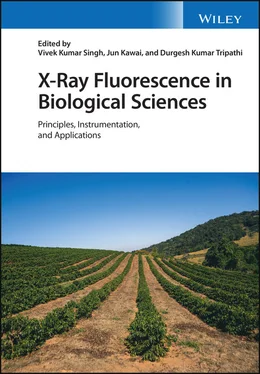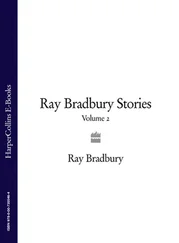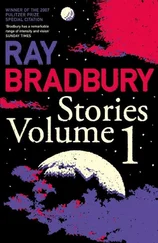X-Ray Fluorescence in Biological Sciences
Здесь есть возможность читать онлайн «X-Ray Fluorescence in Biological Sciences» — ознакомительный отрывок электронной книги совершенно бесплатно, а после прочтения отрывка купить полную версию. В некоторых случаях можно слушать аудио, скачать через торрент в формате fb2 и присутствует краткое содержание. Жанр: unrecognised, на английском языке. Описание произведения, (предисловие) а так же отзывы посетителей доступны на портале библиотеки ЛибКат.
- Название:X-Ray Fluorescence in Biological Sciences
- Автор:
- Жанр:
- Год:неизвестен
- ISBN:нет данных
- Рейтинг книги:5 / 5. Голосов: 1
-
Избранное:Добавить в избранное
- Отзывы:
-
Ваша оценка:
- 100
- 1
- 2
- 3
- 4
- 5
X-Ray Fluorescence in Biological Sciences: краткое содержание, описание и аннотация
Предлагаем к чтению аннотацию, описание, краткое содержание или предисловие (зависит от того, что написал сам автор книги «X-Ray Fluorescence in Biological Sciences»). Если вы не нашли необходимую информацию о книге — напишите в комментариях, мы постараемся отыскать её.
Discover a comprehensive exploration of X-ray fluorescence in chemical biology and the clinical and plant sciences X-Ray Fluorescence in Biological Sciences: Principles, Instrumentation, and Applications
X-Ray Fluorescence in Biological Sciences: Principles, Instrumentation, and Applications
X-Ray Fluorescence in Biological Sciences — читать онлайн ознакомительный отрывок
Ниже представлен текст книги, разбитый по страницам. Система сохранения места последней прочитанной страницы, позволяет с удобством читать онлайн бесплатно книгу «X-Ray Fluorescence in Biological Sciences», без необходимости каждый раз заново искать на чём Вы остановились. Поставьте закладку, и сможете в любой момент перейти на страницу, на которой закончили чтение.
Интервал:
Закладка:
25 25 Kamiloglu, S. (2019). Authenticity and traceability in beverages. Food Chem. 277: 12–24.
26 26 Worku, M., Upadhayay, H.R., and Latruwe, K. (2019). Differentiating the geographical origin of Ethiopian coffee using XRF‐ and ICP‐based multi‐element and stable isotope profiling. Food Chem. 290: 295–307.
27 27 Callao, M.P. and Ruisánchez, I. (2018). An overview of multivariate qualitative methods for food fraud detection. Food Control 86: 283–293.
28 28 Cloete, K.J., Smit, Z., Minnis‐Ndimba, R. et al. (2019). Physico‐elemental analysis of roasted organic coffee beans from Ethiopia, Colombia, Honduras, and Mexico using X‐ray micro‐computed tomography and external beam particle induced X‐ray emission. Food Chem. X 2: 100032.
29 29 Pereira, F.M.V., Pereira‐Filho, E.R., Rodriques, E., and Bueno, M.I.M.S. (2006). Development of a methodology for Ca, Fe, K, Mg, Mn, and Zn quantification in teas using X‐ray spectroscopy and multivariate calibration. J. Agric. Food Chem. 54: 5723–5730.
30 30 Karak, T. and Bhagat, R.M. (2010). Trace elements in tea leaves, made tea and tea infusion: a review. Food Res. Int. 43 (9): 2234–2252.
31 31 Karak, T., Kutu, F.R., Nath, J.R. et al. (2017). Micronutrients (B, Co, Cu, Fe, Mn, Mo, and Zn) content in made tea (Camellia sinensis L.) and tea infusion with health prospect: a critical review. Crit. Rev. Food Sci. Nutr. 57 (14): 2996–3034.
32 32 Kumakhov, M.A. (2000). Capillary optics and their use in x‐ray analysis. X‐Ray Spectrom. 29 (5): 343–348.
33 33 Beckhoff, B., Kanngießer, B., Langhoff, N. et al. (2006). Handbook of Practical X‐Ray Fluorescence Analysis. Springer Science & Business Media.
34 34 Revenko, A.G. (2007). Specific features of X‐ray fluorescence analysis techniques using capillary lenses and synchrotron radiation. Spectrochim. Acta A 62B (6–7): 567–576.
35 35 Yonehara, T., Orita, D., Nakano, K. et al. (2010). Development of a transportable μ‐XRF spectrometer with polycapillary half lens. X‐Ray Spectrom. 39 (2): 78–82.
36 36 Haschke, M. (2014). Laboratory Micro‐X‐Ray Fluorescence Spectroscopy, vol. 55. Springer.
37 37 Szoboszlai, N., Polgári, Z., Mihucz, V.G., and Záray, G. (2009). Recent trends in total reflection X‐ray fluorescence spectrometry for biological applications. Anal. Chim. Acta 633 (1): 1–18.
38 38 Revenko, A.G. (2010). The special features of analytical techniques for geological samples using TXRF spectrometers. Anal. Control 14 (2): 42–64. (in Russian).
39 39 Klockenkämper, R. and von Bohlen, A. (2015). Total‐Reflection X‐Ray Fluorescence Analysis and Related Methods, 2e. New Jersey: Wiley.
40 40 Kawai, J. (2018). Total reflection X‐ray fluorescence. Nark F. Vitha, Series Editor In: Compendium of Surface and Interface Analysis, 763–768. Singapore: Springer.
41 41 Heckel, J., Brumme, M., Weinert, A., and Irmer, K. (1991). Multi‐element trace analysis of rocks and soils by EDXRF using polarized radiation. X‐Ray Spectrom. 20 (6): 287–292.
42 42 Revenko, A.G. (1994). X‐Ray Spectral Fluorescence Analysis of Natural Materials. Novosibirsk: Nauka Publishers (In Russian).
43 43 Margui, E., Padilla, R., Hidalgo et al. (2006). High‐energy polarized‐beam EDXRF for trace metal analysis of vegetation samples in environmental studies. X‐Ray Spectrom. 35 (3): 169–177.
44 44 Hepp, N.M. and James, I.C. (2016). Application of high‐energy polarized energy‐dispersive x‐ray fluorescence spectrometry to the determination of trace levels of As, Hg, and Pb in certifiable color additives. X‐Ray Spectrom. 45 (6): 330–338.
45 45 Palmer, P.T., Jacobs, R., Baker, P.E. et al. (2009). Use of field‐portable XRF analyzers for rapid screening of toxic elements in FDA‐regulated products. J. Agric. Food Chem. 57: 2605–2613.
46 46 Willis, J., Feather, C., and Turner, K. (2014). Guidelines for XRF analysis. Setting up programmes for WDXRF and EDXRF. Cape Town, South Africa: James Willis Consultants cc.
47 47 Fleming, D.E.B., Foran, K.A., Kim, J.S., and Guernsey, J.R. (2015). Portable x‐ray fluorescence for assessing trace elements in rice and rice products: comparison with inductively coupled plasma‐mass spectrometry. Appl. Radiat. Isot. 104: 217–223.
48 48 Towett, E.K., Shepherd, K.D., and Drake, B.L. (2016). Plant elemental composition and portable X‐ray fluorescence (pXRF) spectroscopy: quantification under different analytical parameters. X‐Ray Spectrom. 45 (2): 117–124.
49 49 Ridolfi, S. (2017). Portable Systems for Energy‐Dispersive X‐Ray Fluorescence Analysis. Encyclopedia of Analytical Chemistry. Wiley.
50 50 Revenko, A.G. (1994a). Preparation of samples of natural materials for energy dispersive X‐ray fluorescence analysis. Industrial Lab. Diagn. ‐Mater. 60 (11): 16–29. (in Russian).
51 51 Garivait, S., Quisefit, J.P., de Chateaubourg, P., and Malingre, G. (1997). Multi‐element analysis of plants by WDXRF using the scattered radiation correction method. X‐Ray Spectrom. 26 (5): 257–264.
52 52 Chen, Y., Guo, Z., Wang, X., and Qiu, C. (2008). Sample preparation. Review. J. Chromatogr. A 1184: 191–219.
53 53 Margui, E., Queralt, I., and Van Grieken, R. (2016). Sample preparation for X‐ray fluorescence analysis. R.A. Meyers (Ed.) In: Encyclopedia of Analytical Chemistry. Wiley 25 p.
54 54 Welna, M., Szymczycha‐Madeja, A., and Pohl, P. (2013). A comparison of samples preparation strategies in the multi‐elemental analysis of tea by spectrometric methods. Food Res. Int. 53 (2): 922–930.
55 55 Gunicheva, T.N. and Chuparina, E.V. (2002). Effect of aging reference standard material radiators under direct X‐ray fluorescence analysis of plant materials. Anal. Control 6 (5): 557–565. (in Russian).
56 56 Anjos, M.J., Lopes, R.T., Jesus, E.F.O. et al. (2002). Quantitative determination of metals in radish using x‐ray fluorescence spectrometry. X‐Ray Spectrom. 31 (2): 120–123.
57 57 Queralt, I., Ovejero, M., Carvalho, M.L. et al. (2005). Quantitative determination of essential and trace element content of medicinal plants and their infusions by XRF and ICP techniques. X‐Ray Spectrom. 34 (3): 213–217.
58 58 Chuparina, E.V., Gunicheva, T.N., Belogolova, G.А., and Matushenko, G.V. (2005). Application of X‐ray fluorescence analysis for studying chemical element distributions in different plant parts, examplified artichoke. Anal. Control 9 (4): 405–409. (in Russian).
59 59 Chuparina, E.V. and Gunicheva, T.N. (2004). State and problems of X‐ray fluorescence analysis of plant materials. Anal. Control 8 (3): 211–226. (in Russian).
60 60 Chuparina, E.V. and Martynov, A.M. (2011). Application of nondestructive X‐ray fluorescence analysis to determine the element composition of medicinal plants. J. Anal. Chem. 66 (4): 389–395.
61 61 Anawar, H.M., Canha, N., Freitas, M.C. et al. (2011). Effects of different drying processes on the concentrations of metals and metalloids in plant materials. J. Radioanal. Nucl. Chem. 289: 29–34.
62 62 Kuehner, E.C. and Pella, P.A. (1979). Energy‐dispersive X‐ray spectrometric analysis of NBS standard reference material 1571 orchard leaves after oxidation and borate fusion. Appl. Spectrosc. 33 (6): 632–634.
63 63 Desideri, D., Meli, M.A., Roselli, C., and Feduzi, L. (2011). Polarized X‐ray fluorescence spectrometer (EDPXRF) for the determination of essential and non‐essential elements in tea. Microchem. J. 98: 186–189.
64 64 Desideri, D., Meli, M.A., Roselli, C., and Feduzi, L. (2011). Determination of essential and non‐essential elements in herbal tea and camomile by polarised X‐rays fluorescence spectrometer (EDPXRF). J. Radioanal. Nucl. Chem. 290: 391–396.
65 65 Mbaye, M., Traoré, A., Ndao, A.S., and Wagué, A. (2013). Classification of tea consumed in Senegal using XRF techniques and chemometric based on their country of origin. Afr. J. Agric. Res. 8 (44): 5522–5529.
Читать дальшеИнтервал:
Закладка:
Похожие книги на «X-Ray Fluorescence in Biological Sciences»
Представляем Вашему вниманию похожие книги на «X-Ray Fluorescence in Biological Sciences» списком для выбора. Мы отобрали схожую по названию и смыслу литературу в надежде предоставить читателям больше вариантов отыскать новые, интересные, ещё непрочитанные произведения.
Обсуждение, отзывы о книге «X-Ray Fluorescence in Biological Sciences» и просто собственные мнения читателей. Оставьте ваши комментарии, напишите, что Вы думаете о произведении, его смысле или главных героях. Укажите что конкретно понравилось, а что нет, и почему Вы так считаете.











